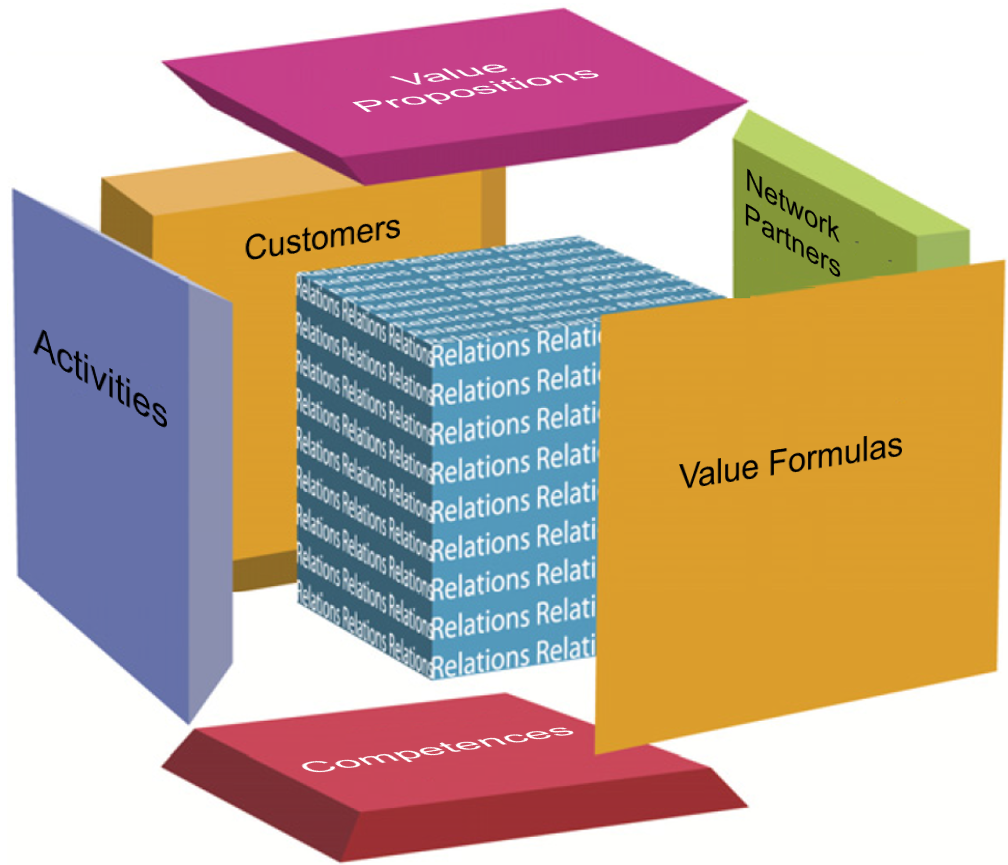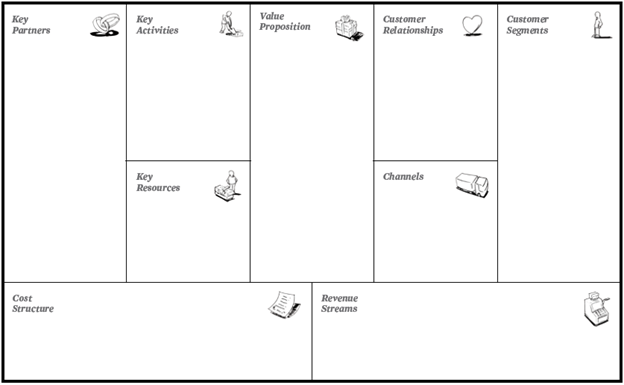Lindgren
A business model describes how an organization creates, captures, delivers, and consumes value from the perspective of primary stakeholders. Peter Lindgren defines seven building blocks of a business model: value proposition, user and consumer, value chain, competencies, network, relations and value formula, Lindgren (2011). These are depicted in the figure below (relationships are in the center, “inside” the cube).

Business Model Cube
All of these building blocks and their related components can be described in terms of more detailed VDML model elements, focusing primarily on the business network level of value exchanges with business partners and customers, but supported by the value streams that identify capabilities, resources, costs and values. The table below outlines the mapping between Lindgren’s six dimensions and relations and VDML concepts.
| VDML Concept | Business Model Cube Concept | Remarks |
|---|---|---|
| Capabilities | Competencies | Competencies in BM may be more general, including resources and methods. |
| Business network | Network | Network in BM includes business partners where the relationships may not be restricted to particular business exchanges. In VDML, a business network can define a range of business relationships or it may be restricted to the parties involved in a particular set of related exchanges. |
| Deliverable flows | Relations | Relations in the BM Cube link internal activities and capabilities with the external BM components. VDML deliverable flows define these relations as well as external exchanges within a business network context. |
| Party | User and customer | In BM cube framework user would refer to parties that do not pay economically for the value proposition offered by the Business Model; customer would most often refer to a typical customer in a market or market segment. In VDML, a customer is a particular party in a business network and may be one of a community of potential customers. Users can be represented as other community(s). related to customer(s), possibly as a business network collaboration. |
| Value stream | Value chain | The concept of a value stream is not an explicit element in VDML, but is the network of activities and capabilities that contribute to the deliverable(s) and values of a value proposition |
| Measure | Value formula (Profit formula) | In VDML, a measure defines how a measurement is determined. Here, a measure may be a formula that combines certain factors from the model to provide a profit measurement (the result of applying the formula). |
| Value proposition | Value proposition | Same concept but more detailed in VDML |
Osterwalder
Alex Osterwalder (2004, 2010) defines nine components: customer segments, customer relationships, distribution channels, revenue streams, value propositions, key activities, key resources, cost structure and key partners. These are depicted in Osterwalder’s graphic in the figure below.

Business Model Canvas Osterwalder
All of these components can be described in terms of more detailed VDML model elements focusing primarily on the business network level of value exchanges with business partners and customers, but supported by the value streams that identify capabilities, resources, costs and values. The table below, outlines the mapping between Osterwalder’s nine components and VDML concepts.
| VDML Concept | Business Model Canvas Concept | Remarks |
|---|---|---|
| Channel | Channel | In VDML, a deliverable flow with channel attribute to define the mechanism of flow, e.g., telephone, email, postal service, etc. In BM Canvas, flows typically are to customers. |
| Value contribution component (cost) | Cost structure | In BM Canvas, cost structure describes all costs to operate the business. In VDML, cost per unit of production is one value that is captured for activities. The VDML model would support aggregation of costs for a capability by reference to the activities that use that capability. The cost to the enterprise would require multiplying the cost per unit of production by associated production volumes (by activity). This can be user defined, and could be computed for a value proposition component. |
| Collaboration | Customer relationships | In BM Canvas, customer relationships are approaches to engaging customers leading to business exchanges. In VDML, collaborations can be defined to represent different types of customer relationships including collaboration with automated and non automated services and collaboration within communities. |
| Community | Customer Segment | In VDML, different customer segments are represented by different communities where a business network will typically engage a typical member as a party in the network. |
| Capability Library | Key activities | In BM Canvas, key activities refer to the most important things a company must do. In VDML, the core things a company does are identified as capabilities in a capability library (taxonomy of capabilities). Key capabilities would highlight those of primary importance. A capability heat map might be used to highlight the key capabilities (i.e., activities). These would likely be capabilities at higher (broader) levels in the taxonomy. |
| Business network | Key partnerships | In BM Canvas, key partnerships refer to the network of suppliers and partners necessary for successful operation of the business. In VDML, a broad business network may represent relationships and key deliverable exchanges with multiple partners and suppliers. Sub-business networks can be used to represent different BM Canvas types of partnerships: Strategic, co-opetition, joint venture, and buyer-supplier. |
| Capability | Key resources | The focus of BM Canvas is resources required to perform including facilities, people, money, etc. In VDML, a capability includes key resources as well as the activities to apply the capability and produce value. |
| Business network | Revenue stream | In BM Canvas, revenue stream is a flow of income from a product or service minus the cost of the product or service. In VDML, the price/revenue and the cost are attributes of value propositions exchanged with other parties in a business network. |
| Value proposition | Value proposition | Same concept. BM Canvas refers to value propositions offered to the market, while VDML expands the concept to value propositions offered between roles in a collaboration. |
Lindgren, P. and Jørgensen,R., M.-S. Li, Y. Taran, K. F. Saghaug, Towards a new generation of business model innovation model, presented at the 12th International CINet Conference: Practicing innovation in times of discontinuity, Aarhus, Denmark, 10-13 September 2011
Osterwalder, A., The Business Model Ontology- A Proposition in a Design Science Approach, Thesis, University of Lausanne, 2004, http://www.hec.unil.ch/aosterwa/PhD/Osterwalder_PhD_BM_Ontology.pdf .

